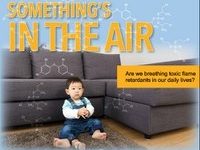Seattle, WA – Are we breathing cancer-causing or neurotoxic toxic flame retardants in our daily lives? Ten Washingtonians discovered the answer to this question is “Yes” when they took part in a new Washington Toxics Coalition study, Something’s In the Air.
The study measured the presence of toxic flame retardants in the air breathed by ten prominent Washingtonians, including elected officials, a firefighter, a social services leader, and environmental experts. The study found that every participant was breathing harmful flame retardants in their daily lives and confirms the air we breathe as a significant source of exposure to these chemicals.
“It’s shocking to find out these toxic flame retardants are in the air I am breathing, despite my best efforts. I’ve worked really hard to minimize my family’s exposure to toxic chemicals. It’s frustrating to find out companies are still putting cancer-causing flame retardants in products I bring into my home,” said Liz Zimmerly, study participant who lives in south Seattle with her two kids and husband.
The toxic flame retardants measured in the study were four chlorinated flame retardants, including Tris and PBDES, and two chemicals used in the Firemaster 550 flame retardant. These chemicals are used in consumer products in our homes, escape from these products, and contaminate house dust and the air. They can cause cancer and harm to the nervous system.
“Our results show that we are breathing in flame retardants that cause cancer and harm to the developing brain,” said Erika Schreder, report author and staff scientist with the Washington Toxics Coalition. “We found that air concentrations are much higher for flame retardants that have come in to heavy use in the last ten years as replacements for phased out flame retardants. Our current laws don’t ensure that when companies stop using a harmful flame retardants, they adopt safer method or chemical.”
Specifically, the study found:
- Toxic flame retardants were in each of the ten participants’ air samples.
- Even though they are phased out, we are still breathing the neurotoxic PBDEs: they were in every air sample.
- Cancer-causing chlorinated Tris flame retardants were found in the highest concentration, and every participant’s sample indicated exposure to at least one.
- The PBDE replacement chemicals found in the Firemaster flame retardant (known as TBB and TBPH) were in half of the personal air samples.
- Out of a total of 22 flame retardants tested for, 17 were detected.
“When I saw the results from my indoor air study I was shocked – these toxic chemicals were present in my house,” said Rep. Tana Senn (D-Mercer Island), study participant. “For the safety of our families and our first responders, we must take action. That’s why I’m proud to be listed as a cosponsor on the Toxic-Free Kids & Families Act.”
Increasing evidence that these toxic flame retardants are harmful to health and unnecessary for fire safety, combined with companies opting to stop using the chemicals in their products, has renewed calls for eliminating the chemicals in homes.
Legislation to ban certain toxic flame retardants in home furniture and children’s products recently passed the Washington State House of Representatives with a bipartisan vote of 95-3. The Toxic-Free Kids and Families Act (HB 1174), sponsored by Rep. Kevin Van De Wege (D-Sequim) and Rep. David Taylor (R-Moxee), would also provide the state with the ability to ban additional cancer-causing and other harmful chemicals from being used as flame retardants provided safer alternatives are available. However, the Senate Environment Committee has passed a severely weakened version of the bill that would not allow the state to ban additional toxic flame retardants, failing to solve the problem of companies switching to equally bad or worse toxic flame retardants. The bill is awaiting a vote of the full Senate.

